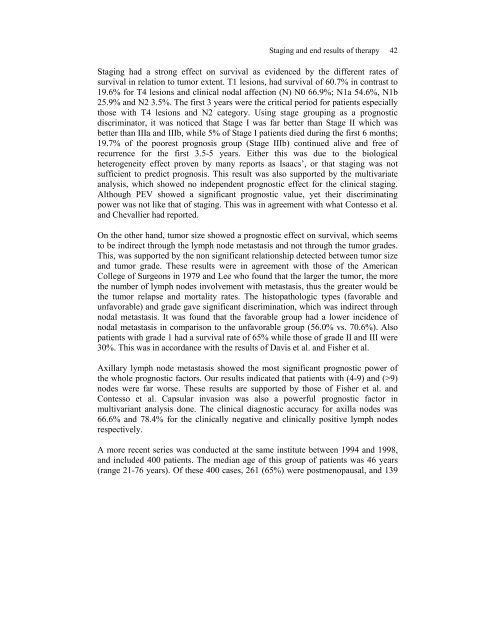Breast Cancer - Arab Medical Association Against Cancer
Breast Cancer - Arab Medical Association Against Cancer
Breast Cancer - Arab Medical Association Against Cancer
- No tags were found...
Create successful ePaper yourself
Turn your PDF publications into a flip-book with our unique Google optimized e-Paper software.
Staging and end results of therapy 42Staging had a strong effect on survival as evidenced by the different rates ofsurvival in relation to tumor extent. T1 lesions, had survival of 60.7% in contrast to19.6% for T4 lesions and clinical nodal affection (N) N0 66.9%; N1a 54.6%, N1b25.9% and N2 3.5%. The first 3 years were the critical period for patients especiallythose with T4 lesions and N2 category. Using stage grouping as a prognosticdiscriminator, it was noticed that Stage I was far better than Stage II which wasbetter than IIIa and IIIb, while 5% of Stage I patients died during the first 6 months;19.7% of the poorest prognosis group (Stage IIIb) continued alive and free ofrecurrence for the first 3.5-5 years. Either this was due to the biologicalheterogeneity effect proven by many reports as Isaacs’, or that staging was notsufficient to predict prognosis. This result was also supported by the multivariateanalysis, which showed no independent prognostic effect for the clinical staging.Although PEV showed a significant prognostic value, yet their discriminatingpower was not like that of staging. This was in agreement with what Contesso et al.and Chevallier had reported.On the other hand, tumor size showed a prognostic effect on survival, which seemsto be indirect through the lymph node metastasis and not through the tumor grades.This, was supported by the non significant relationship detected between tumor sizeand tumor grade. These results were in agreement with those of the AmericanCollege of Surgeons in 1979 and Lee who found that the larger the tumor, the morethe number of lymph nodes involvement with metastasis, thus the greater would bethe tumor relapse and mortality rates. The histopathologic types (favorable andunfavorable) and grade gave significant discrimination, which was indirect throughnodal metastasis. It was found that the favorable group had a lower incidence ofnodal metastasis in comparison to the unfavorable group (56.0% vs. 70.6%). Alsopatients with grade 1 had a survival rate of 65% while those of grade II and III were30%. This was in accordance with the results of Davis et al. and Fisher et al.Axillary lymph node metastasis showed the most significant prognostic power ofthe whole prognostic factors. Our results indicated that patients with (4-9) and (>9)nodes were far worse. These results are supported by those of Fisher et al. andContesso et al. Capsular invasion was also a powerful prognostic factor inmultivariant analysis done. The clinical diagnostic accuracy for axilla nodes was66.6% and 78.4% for the clinically negative and clinically positive lymph nodesrespectively.A more recent series was conducted at the same institute between 1994 and 1998,and included 400 patients. The median age of this group of patients was 46 years(range 21-76 years). Of these 400 cases, 261 (65%) were postmenopausal, and 139









